Porsche 911 GT3
| Porsche 911 GT3 | |
|---|---|
.jpg) The 2019 Porsche 911 GT3 RS on display at the Geneva Motor Show | |
| Overview | |
| Manufacturer | Porsche |
| Production | 1999–present |
| Assembly | Stuttgart-Zuffenhausen, Germany |
| Body and chassis | |
| Class | Sports car (S) |
| Body style | 2-door coupé |
| Layout | Rear-engine, rear-wheel-drive |
| Powertrain | |
| Engine | 3.6–4.0 L Flat-6 |
| Transmission | 6-speed manual or 7-speed dual-clutch |
| Chronology | |
| Predecessor | Porsche 911 Carrera RS (993) |
The Porsche 911 GT3 is a high performance version of the Porsche 911 sports car primarily intended for racing. It is a line of high-performance models, which began with the 1973 911 Carrera RS. The GT3, introduced in 1999, is named after the Fédération Internationale de l'Automobile (FIA) Group GT3 class, in which it was designed to compete.
A number of variations, designed for road and track duty, have been introduced since its launch in 1999. More than 14,000 cars have been produced.
The GT3 has had a successful racing career in the one-make national and regional Porsche Carrera Cup and GT3 Cup Challenge series, as well as the international Porsche Supercup supporting the FIA Formula 1 World Championship. It has won championship and endurance races, including the GT class of the American Le Mans Series seven times, first overall in the 24 Hours of Daytona, and first overall at the 24 Hours Nürburgring six times.
Road cars
996 GT3
| 996 GT3 | |
|---|---|
.jpg) | |
| Overview | |
| Production | 1999–2005 |
| Powertrain | |
| Engine | |
| Dimensions | |
| Length | 174.6 in (4,435 mm) |
| Width | 69.7 in (1,770 mm) |
| Height | 50.2 in (1,275 mm) |
996.1 GT3
The "GT3" nameplate was introduced in 1999 as part of the first generation of the Porsche 996 model range (commonly known as 996.1[1]). As with Porsche's previous 911 RS models, the 996 GT3 was focused on racing, and so was devoid of items that added unnecessary weight to the car. Sound deadening was almost completely removed, as were the rear seats, rear loud speakers, sunroof, and air conditioning, although automatic air conditioning and CD/radio became no-cost optional add-ons.
The engine of the 996 GT3 set it apart from most of the other Porsche 996 models, although it shared the same basic design of the standard so-called "integrated dry sump" flat-six engine. The engine is naturally aspirated and based on the unit used in the Porsche 962 and Porsche 911 GT1 race cars. That engine was known as the 'Mezger' engine, after its designer Hans Mezger. The engine uses the original air-cooled 911's versatile dry-sump crankcase, with an external oil reservoir. The 996 GT3 has 360 PS (265 kW; 355 hp), compared to the 300 PS (221 kW; 296 hp) of the regular Porsche 996. In GT3 configuration, this so-called "split" crankcase (meaning the parting line of crankcase is on the crankshaft centreline) uses, instead of a fan and finned cylinders, separate water jackets added onto each side of the crankcase to cool banks of three cylinders with water pumped through a radiator. Thus, the GT3 engine is very similar to the completely water-cooled Porsche 962 racing car's engine, which is based on the same crankcase. The 962 differs, however, by using six individual cylinder heads while the GT1/GT3, like the air and water-cooled Porsche 959, uses two cylinder heads, each covering a bank of three cylinders. The GT3 engine could thus also be thought of as similar to a 959 engine, but with water-cooled cylinders. Up to early model year 2004 996 GT3 production, the basic casting used for the crankcase of the GT3 was the same as the air-cooled engine. The "964" casting number was visible on the bottom of the crankcase, and on areas normally machined in air-cooled applications, but not in water-cooled ones. The crankcase casting was changed in mid-2004 to a "996" casting number crankcase to eliminate these external air-cooled remnants, but internally it was the same.
Because the 911 air-cooled crankcase uses the Porsche 356 engine to transmission mounting flange configuration, the 996 GT3 used a manual gearbox also of air-cooled 911 heritage. This gearbox has interchangeable gear ratios and is more durable making it more suitable for racing than the standard 911 type 996 gearbox.
To bring the vehicle's track-prowess to the maximum level, Porsche endowed the GT3 with enlarged brakes, a lowered, re-tuned suspension system, lighter-weight wheels and a new front bumper with matched rear spoiler to help increase downforce, thereby increasing grip.
Porsche offered a no-cost option for the GT3 called the 'Clubsport' package. This option replaced the standard electrically adjustable leather front seats with manually adjustable racing buckets finished in fire-retardant fabric, single mass flywheel, bolt-in half-roll cage, 6-point drivers racing harness (also replacing the standard side airbags), fire extinguisher (mounted in the front passenger footwell) and preparation for a battery master switch. The Clubsport option was never offered to US customers, ostensibly due to the additional DOT crash testing that would have been required to allow US sales.
996.2 GT3
Porsche made significant updates to the GT3 for 2004 (the first year the car was offered to US customers), using the 2002 996 facelift including headlights that were differentiated from the Porsche Boxster. The 2004 version is commonly known as the 996.2 GT3.[2] Horsepower was raised to 381 PS (280 kW) and torque to 284 lb⋅ft (385 N⋅m), 80% of which was available from 2,000 rpm. The braking setup was upgraded, now featuring 6-piston calipers on the front (rears remained 4-piston), and the Porsche Ceramic Composite Brake system was offered as an option.
In track testing by American automotive journals, the GT3 managed a 0-60 mph (97 km/h) time of 4.5 seconds and a quarter mile time of 12.0 seconds at 118 miles per hour (190 km/h). During skidpad testing the vehicle posted 1.03g.
Porsche's official test-driver Walter Röhrl completed the Nürburgring Nordschleife with the 996 GT3 in 7 minutes 56 seconds, a feat which was used by Porsche to promote the car.
 1999 Porsche 911 GT3 (996, pre-facelift) front.
1999 Porsche 911 GT3 (996, pre-facelift) front. 1999 Porsche 911 GT3 (996, pre-facelift) rear.
1999 Porsche 911 GT3 (996, pre-facelift) rear.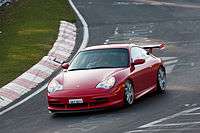 Porsche 911 GT3 (996, post-facelift) front.
Porsche 911 GT3 (996, post-facelift) front..jpg) 2005 Porsche 911 GT3 (996, post-facelift) rear.
2005 Porsche 911 GT3 (996, post-facelift) rear.
996.2 GT3 RS
In 2003, Porsche introduced the Porsche 911 GT3 RS, an even more track-focused version of the 996 GT3. RS is short for the German RennSport, literally "racing sport" in English. The "RS" moniker, and the characteristic lightweight blue or red wheels and "GT3 RS" side stickers link the 996 GT3 RS to historically important Porsches such as the Carrera 2.7 RS of the early 1970s. The 996 GT3 RS is lighter than the 996 GT3 thanks to a polycarbonate rear window, carbon fiber hood and rear wing. Porsche Ceramic Composite Brake (PCCB) Carbon fibre-reinforced Silicon Carbide (C/SiC) ceramic composite brakes, which are also more heat and fade resistant than the cast iron units fitted as standard, are optional.
The 996 GT3 RS has a slightly different engine specification to the 996 GT3. The cylinder heads of the 996 GT3 RS have reshaped intake and exhaust ports for race homologation. Porsche claim the same 381 hp (284 kW) power output as the standard GT3 but Porsche's control dyno showed a jump to nearly 400 hp (298 kW) The RS also has progressive springs rather than linear. The dampers are uprated and are between 10 and 15 percent stiffer than the 996 GT3 in bounce and rebound.
The wheel carriers are totally redesigned to maximize the improved dynamic camber control. The suspension top mounts can be turned 120 degrees to a cup car position. Both front and rear control arms are adjustable. The RS is 3 mm (0.1 in) lower than the 996 GT3.
The RS rear wing delivers 35 kg (77 lb) of downforce at 125 mph (201 km/h). The RS has ram air ducts on the engine bay which force air into the intake with 18mb of pressure at 187 mph (301 km/h) and this is enough to create an additional 15 bhp (11 kW; 15 PS). That extra bhp cannot be homologated since the official engine output figures are certified on a dynanometer.
The Porsche 996 GT3 RS had a production run from 2003 to 2005. Only 140 right hand drive 996 GT3 RS cars were built by Porsche and 113 of those were officially imported into the UK. The 996 GT3 RS was not sold in the United States or Canada.
Automobile magazines claim the 996 GT3 RS can accelerate from 0-60 mph (97 km/h) in about 4.3 seconds, maintain over 1.0g on the skidpad, and have a top speed of around 190 mph (306 km/h).
- Porsche 911 GT3 RS (996) front.
- Porsche 911 GT3 RS (996) rear.
997 GT3
| 997 GT3 | |
|---|---|
_Goodwood.jpg) | |
| Overview | |
| Production | 2006–2011 |
| Powertrain | |
| Engine |
3.6 L 415 PS (305 kW) H6 3.8 L 435 PS (320 kW) H6 3.8 L 450 PS (331 kW) H6 4.0 L 500 PS (368 kW) H6 |
| Dimensions | |
| Length | 174.3 in (4,427 mm) |
| Width | 71.2 in (1,808 mm) |
| Height | 50.4 in (1,280 mm) |
997.1 GT3
In February 2006, Porsche revealed the first generation 997 GT3, commonly now known as the 997.1 GT3.[3] In addition to a new 415 PS (305 kW) 3.6 litre flat-six engine, the vehicle featured "zero lift" aerodynamics, meaning the car creates only aerodynamic downforce and no grip-diminishing "lift" upwards and away from the road surface. The vehicle made use of a modified, track oriented version of Porsche's active PASM suspension making it the first of Porsche's RS or GT3 versions to feature an electronically adjustable suspension system. Also available was a navigation system and Porsche's "sports chrono" gauge package. The car went to sale in summer of 2006 and had a starting price of $106,000 USD. A total of 917 units were sold in the United States and 46 units in Canada.
The vehicle has a rated 0-60 mph (97 km/h) time of 4.1 seconds and has a top speed of 193 mph (311 km/h). Road and Track was able to achieve a 0-60 mph run in 3.8 seconds.[4] Porsche's official test-driver Walter Röhrl completed the Nürburgring Nordschleife in 7 minutes 42 seconds with the 997 GT3 in 2006.
- 2006 Porsche 911 GT3 (997, pre-facelift) front.
- 2006 Porsche 911 GT3 (997, pre-facelift) rear.
997.1 GT3 RS
Porsche also offered an RS version of the 997 GT3. In common with its predecessors, it provided a homologation model for use in a range of racing series. The 997 GT3 RS was released in Europe in October 2006 and in North America in spring 2007.
The 997 GT3 RS is 20 kg (44 lb) lighter than the 997 GT3, weighing in at 1,370[5] kg (3,020 lb). This weight-saving was achieved by the use of an adjustable carbon plastic wing, a steel engine cover, and a lightweight plastic windscreen. The weight savings gives the 997 GT3 RS corresponding engine power to curb weight ratio of 300 bhp (220 kW) per tonne.
The body of the 997 GT3 RS is 64 mm (2.5 in) wider at the rear than the 997 GT3 (a legacy from the Carrera 4 models with which it shares its shell). The muscular-looking rear end conceals a wider track that not only improves directional stability but also increases the potential cornering grip. However, drag is increased and top speed reduced due to the larger rear wing. In addition to the new technology, the paint scheme and body panels are all designed specifically for this car. For the RS version, the limited edition RS Green and RS Orange colour was formulated specially for this car.
The US version of the 997 GT3 RS has a standard rear window (not plexiglas) and the smaller 911 fuel tank to comply with rules of SCCA, Can-Am, and IMSA. For Grand-Am races, the central locking wheel nut is replaced with the standard five-lug pattern required under Grand-Am rules.
Production of the first generation 997 GT3 RS (997.1 GT3 RS[6]) ended in 2009. An estimated 1,168 vehicles were delivered worldwide, with a total of 410 units sold in the United States and 42 units in Canada.[7]
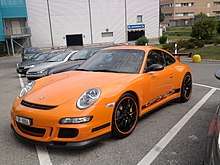 Porsche 911 GT3 RS (997, pre-facelift) front.
Porsche 911 GT3 RS (997, pre-facelift) front. Porsche 911 GT3 RS (997, pre-facelift) rear.
Porsche 911 GT3 RS (997, pre-facelift) rear.
997.2 GT3
In 2009, Porsche launched the 2nd Generation 997 GT3 (commonly now known as the 997.2 GT3[8]), with an enlarged 3.8 litre engine producing 435 PS (320 kW). It also featured a number of new options including dynamic engine mounts and a pneumatically lifting front axle to compensate for the low ground clearance. The rear spoiler was also modified along with other parts of the bodywork. Deliveries in Europe commenced in November the same year. A total of 65 units were sold in the United States and 58 units in Canada.
- Porsche 911 GT3 (997, post-facelift) front.
 Porsche 911 GT3 (997, post-facelift) rear
Porsche 911 GT3 (997, post-facelift) rear
997.2 GT3 RS
For 2010, the second generation 911 GT3 RS (known as 997.2 GT3 RS[9]) received an additional 15 PS (11 kW; 15 hp) due to a new 3.8-litre flat-6 engine, bringing total power output up to 450 hp (336 kW; 450 hp). The car was not approved for competition in the United States by IMSA American LeMans. Grand-Am originally did not approve the car, but after performance issues (a Porsche team did not compete at the Indy Grand Prix of Alabama round), Grand-Am approved the second-generation car in April 2010.[10][11]
Fifth Gear carried out a road test on the 997 911 GT3 RS which highlighted the exceptional performance of the car[12]
Porsche test driver had intended[13] to enter the 2011 12 Hours of Nürburgring on a standard road legal 911 GT3 RS, but had to withdraw due to health reasons from the team that comprised racers Roland Asch and Simon Cowell, plus journalists Horst von Saurma and Chris Harris. The car, entered in cooperation with sport auto (Germany),[14] is registered as S-GO 2400, and was driven from Weissach to Nürburg. The RS was modified according to safety requirements, which included a larger roll cage and fire extinguisher. As no race tyres were available for 19" wheels, the 18" wheels of the Carrera Cup racers were used. Asch qualified with 9:15, 42nd overall, and 9th[15] among the 17 SP7 class entrants, only beaten by its race-prepared Porsche 997 siblings. In an otherwise disappointing race for Porsche, with the best race 997 finishing only 6th, the road legal car did 145 laps, only 9 less than the winning BMW, for place 13.[16] It supposedly had to cover another 306 km, on the Autobahn back home.
Of the 997.2 GT3 RS a total of 541 units sold in the United States and 71 units in Canada.
.jpg) Porsche 911 GT3 RS (997, post-facelift) front.
Porsche 911 GT3 RS (997, post-facelift) front..jpg) 2010 Porsche 911 GT3 RS (997, post-facelift) rear.
2010 Porsche 911 GT3 RS (997, post-facelift) rear.
997.2 GT3 RS 4.0
The 911 GT3 RS 4.0, launched in 2011, was the final evolution of the 997 GT3 and featured a 4.0 litre flat-six engine (the largest engine offered in a street-legal 911).[17] The engine itself uses the crankshaft from the RSR with increased stroke dimensions (from 76.4 mm to 80.4 mm). This change has increased the power to 368 kW (500 PS; 493 hp) at 8250 rpm and 460 N⋅m (339 lbf⋅ft) of torque at 5750 rpm. Chassis development has been influenced by the GT2 RS and uses parts from other RS 911s. Front dive planes give additional downforce up front. The car weighs in at 1,360 kg (2,998 lb),[18] giving it a power-to-weight ratio of 365 bhp per ton. Only 600 cars were built.[17][19] At 493 hp (368 kW),[20] the engine is one of the most powerful six-cylinder naturally aspirated engines in any production car with a 123.25 hp (92 kW) per litre output.
Performance is 3.5 seconds for 0-60 miles per hour (97 km/h) and a top speed of 193 mph (311 km/h).[21] The lap time on the Nürburgring Nordschleife is 7 minutes and 27 seconds.[22]
The car was offered in Black, Carrera White, Paint to Sample Non Metallic and Paint to Sample Metallic. A total of 141 units were sold in the United States and 16 units in Canada.
 2011 Porsche 911 GT3 RS 4.0 (997) front.
2011 Porsche 911 GT3 RS 4.0 (997) front..jpg) Porsche 911 GT3 RS 4.0 (997) rear.
Porsche 911 GT3 RS 4.0 (997) rear.
991 GT3
| 991 GT3 | |
|---|---|
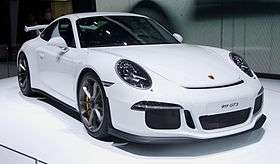 | |
| Overview | |
| Production | 2013-present |
| Powertrain | |
| Engine |
3.8 L 475 PS (349 kW) H6 4.0 L 500 PS (368 kW) H6 |
| Dimensions | |
| Length | 178.94 in (4,545 mm) |
| Width | 72.91 in (1,852 mm) |
| Height | 49.96 in (1,269 mm) |
991.1 GT3
Porsche introduced the 991 GT3 at the Geneva Motor Show in 2013.[23] The 991 GT3 features a new 3.8 litre direct fuel injection (DFI) flat-six engine developing 475 hp (354 kW; 482 PS) at 8,250 rpm, a Porsche Doppelkupplung (PDK) double-clutch gearbox and rear-wheel steering. The engine is based on the unit fitted in the 991 Carrera S, but shares only a few common parts. All other components, particularly the crankshaft and valve train, were specially adapted or developed for the 991 GT3.[24] For example, the 991 GT3's engine uses titanium connecting rods attached to forged piston, in order to allow the engine to reach up to 9,000 rpm. The dual-clutch gearbox is another feature specially developed for the 991 GT3, based on sequential manual transmissions used in racing cars.[25]
After a number of engine failures, it was discovered that the supplier of the connecting rod bolts had made a production error in the alloy of the bolt.[26] Subsequently, all 785 of the GT3s that had been produced up to that point were recalled to the dealership organisations and fitted with new engines, and all owners were issued with an extra year's warranty.[27]
%2C_rear_left.jpg)
A formal letter sent to Porsche from members of the US-based Rennlist.com "991.1 GT3 Concerned Owners Group" about additional engine durability issues lead to a meeting between representatives of the owners group and Porsche, including head of Porsche Motorsport Dr. Frank-Steffen Walliser, on 3 August 2017 at the Porsche North America Atlanta headquarters. According to Dr. Walliser the concerning high-RPM misfire issue could be traced primarily to a metallurgical defect in certain batches of "finger followers" (valve train rocker arms) and secondarily to individual driving patterns and engine variations - such as temperature, oil quality, oil viscosity and parts tolerances - that lead to increased wear of the specific parts. In response to the issue and after implementing new engine tests to trace down the issue Porsche had developed revised camshafts and finger followers and offers a fully transferable 10-year, 120,000 mile extended engine warranty to all 991.1 generation GT3 owners worldwide that covers the replacement of the defective engine with a new engine with the revised parts if failure is a direct result of the finger-follower issue. The base bumper-to-bumper warranty and all other warranty terms and conditions remain unchanged. Porsche confirms that the issue is isolated to the 991.1 GT3, and that the 991.1 GT3 RS and the 991 R are not affected.[28][29][30][31]
The 911 GT3 is claimed to be able to accelerate from 0-60 mph (97 km/h) in 3.1 seconds or less, and the quarter mile in 11.2 seconds at 126 mph (203 km/h).[32][33] The GT3 has a claimed top speed of 202 mph (325 km/h). The lap time on the Nürburgring Nordschleife is 7 minutes and 25 seconds.[34]
991.1 GT3 RS
Porsche launched the RS version of the 911 GT3 at the Geneva Motor Show in 2015.[35] Compared to the 911 GT3, the front fenders are now equipped with louvers above the wheels and the rear fenders now include Turbo-like intakes, rather than an intake below the rear wing. The roof is made from magnesium. The interior includes full bucket seats (based on the carbon seats of the 918 Spyder), carbon-fibre inserts, lightweight door handles and the Club Sport Package as standard (a bolted-on roll cage behind the front seats, preparation for a battery master switch, and a six-point safety harness for the driver and fire extinguisher with mounting bracket).The car was nominated as one of the Britain's best driver's car 2014 by Autocar magazine.
The 3.8-litre unit found in the 911 GT3 is replaced with a 4.0-litre unit with 500 hp (370 kW) and 339 lb ft (460 N·m) of torque. The transmission is PDK only. The drivetrain delivers 0-62 mph (100 km/h) in 3.4 seconds (0.6 seconds quicker than the 997 GT3 RS 4.0) and 0-124 mph (200 km/h) in 10.9 seconds. The 991 GT3 RS also comes with functions such as declutching by "paddle neutral" — comparable to pressing the clutch with a conventional manual gearbox –- and Pit Speed limiter button. As with the 911 GT3, there is rear-axle steering and Porsche Torque Vectoring Plus with fully variable rear axle differential lock. The Nürburgring Nordschleife time is 7 minutes and 20 seconds.[36]
991.2 GT3
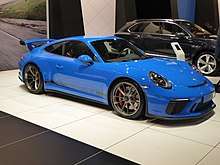
Porsche unveiled the facelifted 991.2 GT3 at the 2017 Geneva Motor Show. Extensive changes were made to the engine allowing for a 9,000 rpm redline from the 4.0 litre flat-six engine. Porsche's focus was on reducing internal friction to improve throttle response. Compared to the 991.1, the rear spoiler is higher and located further back to be more effective. There is a new front spoiler and changes to the rear suspension. The 991.2 GT3 brought back the choice between a manual transmission or a PDK dual clutch transmission.
GT3 Touring
.jpg)
.jpg)
Following the roots of the 2016 911R, a touring version of the GT3 was introduced that removes the rear wing and replaces it with the rear spoiler from the Carrera GTS to give a more smooth and flowing aesthetic image, though it extends further upwards to provide extra downforce. The Touring is only available with a manual transmission, features leather versus Alcantara, and cannot be specified with the Clubsport package available with the normal GT3. The suspension settings are said to be identical to the standard GT3 as is the engine. The touring, unlike the 911R is not produced in limited numbers therefore discouraging high price speculation.
991.2 GT3 RS
.jpg)
In February 2018, Porsche revealed a facelifted GT3 RS model to continue their updates for the 991 generation of the 911. Changes include a new engine similar to the GT3 and RSR models with a 9,000 rpm redline and 20 PS (15 kW; 20 bhp) and 10 N⋅m (7.4 lb⋅ft) increase over the previous GT3 RS, NACA ducts for brake cooling, modified front fascia (similar to the 991.2 GT3), side skits and rear wing (similar to the GT2 RS) for increased downforce, ball joints on all suspension links, front helper springs, lightweight glass for the rear and rear-side windows and a newly developed tyre compound. A Weissach package including additional carbon fibre body and interior parts as well as magnesium wheels and stiffer suspension settings is available as an option.[37]
On 18 April 2018 the 991.2 GT3 RS set a lap time of 6:56.4 around the infamous Nürburgring Nordscheleife race track. It is the third Porsche production car to break the 7 minute barrier around the track, the first being the 918 Spyder.[38]
Specifications (road cars)
| Car | Years of Production | Engine Displ. (cm³) | Power | Torque | DIN Kerb Weight | Units Built[39] | 0–62 mph (0–100 km/h) | Top speed |
|---|---|---|---|---|---|---|---|---|
| 996.1 GT3 | 1999-2001 | 3,600 | 360 PS (265 kW; 355 bhp) | 370 N⋅m (273 lbf⋅ft) | 1,350 kg (2,976 lb) | 1,868 | 4.8s (manual) | 302 km/h (188 mph) |
| 996.2 GT3 | 2003-2005 | 3,600 | 381 PS (280 kW; 376 bhp) | 385 N⋅m (284 lbf⋅ft) | 1,380 kg (3,042 lb) | 2,313 | 4.5s (manual) | 306 km/h (190 mph) |
| 996.2 GT3 RS | 2003-2004 | 3,600 | 381 PS (280 kW; 376 bhp) | 385 N⋅m (284 lbf⋅ft) | 1,360 kg (2,998 lb) | 682 | 4.4s (manual) | 306 km/h (190 mph) |
| 997.1 GT3 | 2006-2009 | 3,600 | 415 PS (305 kW; 409 bhp) | 405 N⋅m (299 lbf⋅ft) | 1,394 kg (3,073 lb) | 2,378[40] | 4.3s (manual) | 310 km/h (193 mph) |
| 997.1 GT3 RS | 2006-2009 | 3,600 | 415 PS (305 kW; 409 bhp) | 405 N⋅m (299 lbf⋅ft) | 1,375 kg (3,031 lb) | 1,106 | 4.2s (manual) | 310 km/h (193 mph) |
| 997.2 GT3 | 2009-2011 | 3,797 | 435 PS (320 kW; 429 bhp) | 430 N⋅m (317 lbf⋅ft) | 1,394 kg (3,073 lb) | 2,256[41] | 4.1s (manual) | 312 km/h (194 mph) |
| 997.2 GT3 RS | 2009-2011 | 3,797 | 450 PS (331 kW; 444 bhp) | 430 N⋅m (317 lbf⋅ft) | 1,370 kg (3,020 lb) | 1,600 | 4.0s (manual) | 310 km/h (193 mph) |
| 997.2 GT3 RS 4.0 | 2011 | 3,996 | 500 PS (368 kW; 493 bhp) | 460 N⋅m (339 lbf⋅ft) | 1,360 kg (2,998 lb) | 600 | 3.9s (manual) | 310 km/h (193 mph) |
| 991.1 GT3 | 2013-2016 | 3,799 | 475 PS (349 kW; 469 bhp) | 440 N⋅m (325 lbf⋅ft) | 1,430 kg (3,153 lb) | 5,500 | 3.5s (PDK) | 315 km/h (196 mph) |
| 991.1 GT3 RS | 2016-2017 | 3,996 | 500 PS (368 kW; 493 bhp) | 460 N⋅m (339 lbf⋅ft) | 1,420 kg (3,131 lb) | 6,500 | 3.3s (PDK) | 310 km/h (193 mph) |
| 991.2 GT3 | 2017- | 3,996 | 500 PS (368 kW; 493 bhp) | 460 N⋅m (339 lbf⋅ft) | 1,430 kg (3,153 lb) (PDK), 1,413 kg (3,115 lb) (manual) | In production | 3.4s (PDK), 3.9s (manual) | 318 km/h (198 mph) (PDK) 320 km/h (199 mph) (manual) |
| 991.2 GT3 RS | 2018- | 3,996 | 520 PS (382 kW; 513 bhp) | 470 N⋅m (347 lbf⋅ft) | 1,430 kg (3,153 lb) | In production | 3.2s (PDK) | 312 km/h (194 mph) |
Motorsport
Racing cars
Many different race versions of the 911 GT3 have entered competition since 1998:
996 GT3 Cup (1998–2001)
Basis for the upcoming 996 GT3 road car, featuring a 3.6 litre (bore×stroke: 100mm×76.4mm) boxer engine on basis of the GT1 block developing 265 kW (360 PS; 355 bhp) at 7,200 rpm and 360 N⋅m (266 lbf⋅ft) at 6,250 rpm, with a redline of 8,000 rpm, mated to a six-speed manual transmission. For the 1999 season the engine output was increased to 272 kW (370 PS; 365 bhp) and 370 N⋅m (273 lbf⋅ft) at 6,250 rpm. The fuel cell holds 64 litres and the car weighs in at 1,140 kg (2,513 lb). Slick tyres supplied by Pirelli measured 245/645-18 front to 305/645-18 rear, brake disks measured 330 mm and ABS was standard. The car managed the 0-100 km/h (62 mph) sprint in four seconds, with a top speed of 286 km/h (178 mph). For the 2001 season the GT3 Cup received modified aerodynamics including an enlarged rear wing and improved cooling.[42][43]
Raced in the Porsche Supercup from 1998 to 2001.
996 GT3 Cup (2002–2004)
In 2002 the GT3 Cup received several changes based on the 996.2 Carrera and Turbo models, including Turbo-style headlights. The new body significantly improves aerodynamics and cooling. Engine output is increased to 280 kW (381 PS; 375 bhp) and 380 N⋅m (280 lbf⋅ft), further changes include improved transmission cooling, a lightened exhaust system and other light-weighing measures across the car. Slicks supplied by Michelin measured 24/64-18 front and 27/68-18 rear. Front brake disks increase to 350 mm in diameter, clamped by six-piston calipers. Weight remains at 1,140 kg (2,513 lb) dry.[44][45]
Raced in the Porsche Supercup from 2002 to 2004.
996 GT3 RSR (2004)
997 GT3 Cup (2005–2008)
.jpg)
The new Cup car based on the 997 generation of 911. Its 3.6 litre engine puts out 294 kW (400 PS; 394 bhp) at 7,000 rpm and 400 N⋅m (295 lbf⋅ft) at 6,500 rpm and is now mated to a six-speed sequential transmission. The 997 features significantly improved aerodynamics and lightweight CFRP parts, including doors, rear body panels, engine deck lid and rear wing. Parts of the suspension are adopted from the GT3 RSR. Brake disks are 380 mm front and 350 mm in the rear in diameter and ABS with four control settings is standard.</ref>[47]
Raced in the Porsche Supercup from 2005 to 2007.
997 GT3 RSR (2006–2012)
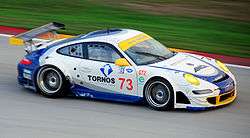
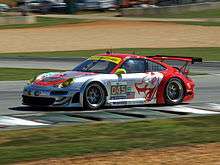
The Porsche 997 GT3 RSR was developed for the GT2 category. In 2007 Porsche added front air louvers that channel air into the radiators and exit through the bonnet. For 2011 Porsche added splitters to the front and increased the tyre diameter to cope with the understeer problem.
The 997 GT3 RSR has scored many class victories around the world, including first-place finishes at the 2011 and 2013 Petit Le Mans. The 997 GT3 RSR set a Nürburgring Nordschleife lap time record for non-turbocharged cars at 7:07 while driven by Sabine Schmitz.[48] [49]
997 GT3 Cup S (2008–2010)
Homologated on basis of the GT3 RS road car instead of the GT3 and destined for international FIA GT3 customer racing. Suspension components have been adopted from the GT3 RSR. [50]
997 GT3 Cup 3.8 (2009–2013)
Based on 997.2 GT3 RS, the car features a new 3.8 litre engine with an output of 331 kW (450 PS; 444 bhp) at 7,500 rpm and an 8,500 rpm redline. Further changes include a 44 mm (1.7 in) wider rear body, 15 mm (0.59 in) lower front spoiler lip, an enlarged rear wing adopted from 911 GT3 Cup S measuring 1.70 m (67 in), new LED tail lights and a modified racing exhaust system. 9.5Jx18 front alloy wheels with 24/64-18 Michelin racing tyres and 12Jx18 alloy wheels with 27/68-18 tyres, additional Unibal joints on the track control arms and front and rear sword-shaped anti-roll bars with seven position settings each, additional vent in the upper part of the front lid, steering wheel mounted Info Display with 6 switches. The car weighs in at 1,160 kg (2,557 lb).
The vehicle was unveiled at the 2009 Frankfurt Motor Show and deliveries began in the same year. The base MSRP of the European model was €149,850 (before tax).[51][52]
Raced in the Porsche Supercup from 2008 to 2012.
997 GT3 R (2010–2013)
Replacing the GT3 Cup S and built from the ground up for FIA GT3 regulations the GT3 R features a 4.0 litre, 368 kW (500 PS; 493 bhp) boxer engine, a six-speed sequential transission, a throttle-blip function, ABS and traction control. Base MSRP was 279,000 Euro (excl. taxes).[53]
For 2013 Porsche significantly modified the vehicle, changed the aerodynamics and increased the track, wheelbase and tyre width by several centimetres. An Evo conversion kit was offered to customers for 45,500 Euro (excl. taxes).[54]
997 GT3 R Hybrid (2010–2011)
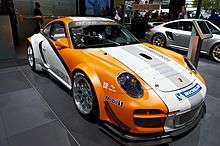
The new Porsche 997 GT3 R Hybrid made its debut at the 2010 Geneva Motor Show. The hybrid technology featured in the car was developed by the Williams F1 Team and is based on their F1 kinetic energy recovery system (KERS) which they did not race in 2009.[55] Unlike other KERS that were developed for F1, the Williams system is based on using kinetic energy stored in a flywheel rather than batteries. The GT3-R has two electric motors, both developing a total output of at least 218 bhp (163 kW), driving the front wheels to supplement the 500 bhp (370 kW) four-litre flat-six engine at the rear.[56] It is planned to enter the car in the 2010 24 Hours Nürburgring.[57][58] As part of the buildup to the 24 hour race the GT3 Hybrid made its racing debut at the VLN 4 hour endurance 57th ADAC Westfalenfahrt at Nürburgring on March 27, 2010.[59] On May 28, 2011, it won its first VLN race.[60] At the 2011 24 Hours of Nurburgring, weight/restrictor penalties as well as technical difficulties prevented the R Hybrid from climbing higher than 28th place. The car also ran as an unclassified car at the 2011 American Le Mans Series at Monterey event; despite starting from last place, it finished ahead of all the other GT cars and also performed the fastest GT lap of the race.
997 GT3 RSR (2012)
991 GT3 Cup (2013–2017)

Porsche introduced the 991 GT3 Cup for the 2013 Porsche Supercup season, based on the 991 GT3. Like the 991 GT3 road car, its improvements over the 997 model include revised aerodynamics, an improved rollcage, new wheels and a revised chassis. The direct-injection 3.8-litre flat six produces 338 kW at 8500 rpm and drives the rear wheels through a mechanical limited slip diff. The transmission includes a paddle-shift, race-bred, pneumatically-activated six speed developed specifically for the track. It uses lightweight materials in its construction, and a stripped-out cabin complete with a full roll cage, racing seat and all the safety gear required for competition, weighing 1175 kg.[62][63]
Raced in the Porsche Supercup from 2013 to 2016.
991 RSR (2013–2017)
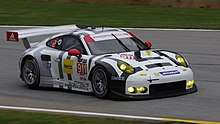
In 2013, Porsche introduced the newest version of the RSR based on the 991 model for the LM GTE category.[64] Because the 991 GT3 was not in production at the time of the announcement, Porsche was forced to homologate it based on the 911 Carrera model. The 991 RSR includes revised aerodynamics, a lighter gearbox and a new, lower suspension.[65] For the 2013 season, Porsche retained the Mezger engine of the 997 GT3 RSR model. Manthey Racing was chosen to run the cars in the FIA World Endurance Championship; the team achieved its best success at the 2013 24 Hours of Le Mans where the 991 RSR finished 1-2 in the GT class.[66]
For 2014, Porsche announced that it partnered with CORE Autosport to run two Porsche 911 RSRs in the United SportsCar Championship (under the Porsche North America team name) while AKB GT Raceline has announced that they would run a pair of 911 RSRs in the series. Team Falken Tire also announced that it would be running a 911 RSR from Sebring onwards. Manthey Racing will continue to run two 911 RSRs in the WEC.
991 GT America (2014)
Porsche also announced a variant of the 991 GT3 Cup car for the United SportsCar Championship known as the 911 GT America.[67] The car is homologated exclusively for the Grand-Touring Daytona category of the series. Upgrades over the regular Cup car include improved aerodynamics, a bigger 4.0L flat-six engine, a new gearbox, a different safety cell, new brakes and reliability upgrades for endurance racing.
991 GT3 R (2016–)
.jpg)
In May 2015, Porsche announced the release of the 991 GT3 R, a customer race car designed to compete in Group GT3 from 2016 onwards. The car is homologated based on the 991 GT3 RS road car, and uses the production car's 4.0-litre flat-six with around 500 bhp (370 kW), running through a six-speed paddle-shift sequential gearbox. The GT3 R features a double-bubble roof, and a wheelbase which had been lengthened by 8.3 cm. Engineers also "significantly optimised" the centre of gravity position versus the old R, using carbon-fibre composite material (CFRP) for the roof, front cover and fairing, wheel arches, doors, side and tail sections as well as the rear cover. All windows – and for the first time ever, the windscreen – are made from polycarbonate to cut weight. Race car essentials such as an integrated (welded) roll cage according to FIA Appendix J, safety fuel cell (approximately 120 litres, with fuel cut off safety valve in accordance with FIA regulations), removable roof escape hatch and an air jack system are present. The weight is 1,220 kg (2,690 lb).
The GT3 R has adopted the concept of the central radiator from its 911 RSR big brother. By eliminating the side radiators, the position of the centre of gravity is improved, the radiator is better protected against collision damage, and the venting of hot air through louvres in the front cover is enhanced. The two-metre wide rear wing lends aerodynamic balance and distinctive wheel arch air vents on the front fairings increase downforce at the front axle. The GT3 R's front MacPherson strut suspension and multi-link rear suspension are adjustable in height, camber and toe, and there are adjustable anti-roll bar blades at both ends. All wheel hubs come with centre-lock wheel nuts. There are two separate brake circuits for the front and rear axles; driver adjustable via a brake balance bar system. The front brakes consist of six-piston aluminium monobloc calipers gripping 380 mm discs; the rears are four-piston items with 372 mm discs.[68]
The Porsche 911 GT3 R is priced 429,000 Euro excluding country-specific taxes.
991 RSR (2017–)
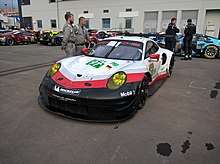
In November 2016, Porsche revealed the new version of the 911 RSR prepared for the LM GTE category. The car has a rear mid-engined design, powered by a four-liter flat-six boxer engine, producing around 510 PS (375 kW; 503 bhp) depending on series air restrictor. Other new features include a new transmission, a new aerodynamic pack including a swan-neck wing and a larger rear diffuser, quick-change body panels and double-wishbone suspension with quick-change shim-system all around, Bertrandt-developed LED lights first developed for the Porsche 919 Hybrid and new cockpit with fixed seat, movable pedal box, multi-function steering wheel with integrated display, a rear-view camera and collision avoidance system. The new RSR made its competition debut at the 2017 24 Hours of Daytona.[69][70]
At the 2018 24 Hours of Le Mans the Manthey Racing-entered Porsche Team 911 RSR #92 and #91 finished 1-2 in the GTE Pro class respectively. Both #92 and #91 carried a special liveries marking the 70th anniversary of the marque with the liveries being the liveries from the past racing cars built by Porsche. The #92 carries the "Pink Pig" livery, homage to the Porsche 917/20 which used the same livery, and the #91 carries the iconic Rothmans-inspired livery from the 80s Porsche 956 and the Porsche 962.[71]
991 GT3 Cup (2017–)
Revealed at the 2016 Paris Motor Show, the 2017 911 GT3 Cup is based on the 991.2 911 GT3. Improvements on the previous model include a larger 4.0-litre flat-six boxer engine delivering performance of 485 PS (357 kW; 478 bhp), improved aerodynamics and an enlarged escape-hatch in the roof. The GT3 Cup is priced at 189,900 Euro excluding taxes.[72]
It has been raced in the Porsche Supercup since 2017.
991 GT3 R (2019–)
In May 2018 Porsche revealed a new iteration of the 911 GT3 R based on the 991.2 GT3 RS, available for customer teams for the 2019 season. Its 4.0-litre flat-six boxer engine, largely identical to the unit used in the GT3 and GT3 RS street cars and GT3 Cup and RSR race cars, develops approx. 550 PS (405 kW; 542 bhp). Improvements include a larger diffuser for more efficient aero, double wishbone front suspension adopted from the RSR, a shim system allowing setup changes without new alignment, larger front tyres, an electro-hydraulically actuated clutch allowing the removal of the clutch pedal, a fuel cell that can be configured to be refilled from left or right of the vehicle depending on circuit layout, a rear-view camera and collision avoidance system, a fixed seat with movable pedal-box and energy-absorbing impact elements placed in the doors for improved safety as well as air conditioning. The GT3 R is priced at 459,000 Euro excluding taxes.[73][74]
Racing history
Apart from numerous class wins, the 911 GT3 won major events overall:
- 24 Hours Nürburgring in 2000, 2006, 2007, 2008, 2009, 2011, 2018 by Manthey Racing team
- Various VLN races at the Nürburgring.
- Spa 24 Hours in 2003, 2010
- 24 Hours of Daytona in 2003
- Petit Le Mans in 2015
Porsche Cup
Various national and regional Porsche Carrera Cup and Porsche GT3 Cup Challenge as well as the international Porsche Supercup one-make series - which serves as Formula One support series - utilise the 911 GT3 since 1998.
1999
Due to the absence of the official Porsche team in the 1999 24 Hours of Le Mans, only privateers with the nearly obsolete air-cooled 993 GT2 Turbo were expected to represent the marque, with few chances to beat the Chrysler Viper for GTS class honors. Two new race versions of the water-cooled 996 GT3-R were entered in the GT class by private teams. The car entered by the German Manthey Racing team finished 13th overall.
2000s
The 996 GT3-R were made available to privateer teams. In the 24 Hours Nürburgring of the year 2000, a factory-backed effort of the local Phoenix team managed to beat the Zakspeed Chrysler Viper that dominated this race from 1998 to 2000. The improved 996 GT3-RS version of 2001 was entered in countless races in the years to follow, scoring not only many class wins, but also overall wins at Daytona and Spa in 2003. In 2004, the 996 GT3-RSR was made available, with numerous improvements to the RS, including a sequential gearbox, which allows for faster gearshifts.
VLN
In 2005, the new 997-generation racing vehicles began to debut with the GT3 Cup, followed by the launch of the 911 GT3-RSR at the 2006 Spa 24 Hours. In VLN endurance races, the Manthey entry won the last 4h race before the 24h event, and then the big event also. Their Porsche 997 GT3 RSR has a larger front splitter, taller rear wing and a 500 PS (368 kW; 493 bhp) 4.0L Flat-6 engine.
24 Hours of Le Mans
After winning the 1998 24 Hours of Le Mans outright, Porsche dominated the GT/N-GT class at Le Mans. There were no major competitors and Porsche took seven consecutive class wins from 1999 to 2005. In 2006 the Porsches led for much of the race but one by one the competitors had problems and withdrew. Last minute mechanical issues threw the Seikel car back behind the surprising winner, the Panoz Esperante GTLMM.
2007 saw the debut of the 997 GT3 RSR. IMSA Matmut took pole by more than a second over the Ferrari (but lost it after breaching Parc Fermé rules). The new Porsche was now fitted with wider rear tyres and smaller restrictors than the rules allow. This was compensated by the car weighing 100 kg more. The Porsche now stood at 1,220 kg (2,690 lb) and 485 PS (357 kW; 478 bhp). This was an advantage at Le Mans over the lighter and nimbler F430.
Le Mans Series
Felbermayr-Proton and IMSA Performance Matmut received the new 997 just before the 2007 season. Marc Lieb and Richard Lietz share the better of the two Felbermayr cars. Patrick Pilet and Raymond Narac share the IMSA car. Felbermayr-Proton won the championship in 2009 and 2010. In 2011, Nicholas Armindo won the GTE-Am class.
.jpg) 2003 Porsche 911 GT3 RS (996) rear.
2003 Porsche 911 GT3 RS (996) rear.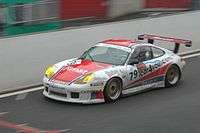 2005 Porsche 911 GT3 RS (996) front.
2005 Porsche 911 GT3 RS (996) front.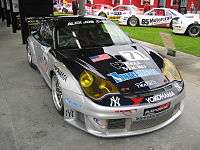 Porsche 911 GT3 RSR (996) front.
Porsche 911 GT3 RSR (996) front.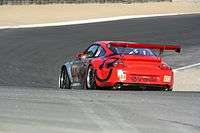 Porsche 911 GT3 RSR (996) rear.
Porsche 911 GT3 RSR (996) rear.- Porsche 911 GT3 RS GT300 (996) front.
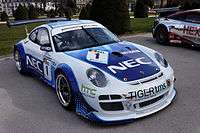 2011 Porsche 911 GT3 R (997) front.
2011 Porsche 911 GT3 R (997) front.
See also
- 9ff GT9, a high-speed automobile, based on the 997 GT3
- Ruf RGT, a sports car similar to the GT3 built by Ruf Automobile
References
- ↑ "996.1 GT3". Total 911 Magazine.
- ↑ "996.2 GT3". Total 911 Magazine.
- ↑ "997.1 GT3". Total 911 Magazine.
- ↑ Elfalan, Jonathan (September 2009). "2010 Porsche 911 GT3". Road & Track. Hachette Filipacchi Media. 61 (1): 59. Archived from the original on 2009-08-15. Retrieved 2009-08-15.
- ↑ http://press.porsche.com/vehicles/10_press_kits/pdf/2010_911_GT3-RS_Specs.pdf
- ↑ "997.1 GT3 RS". Total 911 Magazine.
- ↑ "Issue 66". Total 911 Magazine.
- ↑ "997.2 GT3". Total 911 Magazine.
- ↑ "997.2 GT3 RS". Total 911 Magazine.
- ↑ "2010 Porsche 911 GT3 RS: Track-Ready, Street-Legal And More Power". Jalopnik.com. Retrieved 2009-08-19.
- ↑ "Grand-Am to allow performance Enhancement for Porsches". Grand American Road Racing Association. 2010-04-16. Archived from the original on 2011-07-11. Retrieved 2010-07-23.
- ↑ alexonx (November 10, 2010). "Fifth Gear test the Porsche 911 GT3 RS 2011". Motoriblog.net. Retrieved November 10, 2010.
- ↑ "January - March - Archive 2010 - Porsche AG - Dr. Ing. h.c. F. Porsche AG". US: Porsche. Retrieved 2011-04-24.
- ↑ "24h-Projekt Langstreckenrennen Nürburgring 2010: Rennwagenumbau Porsche 911 GT3 RS | sport auto". Sportauto-online.de. 2010-03-24. Retrieved 2011-04-24.
- ↑ "38. ADAC Zurich 24h Rennen" (PDF). ADAC. 2010-03-16. Archived from the original (PDF) on 2014-12-22. Retrieved 2013-08-03.
- ↑ "Results: 24h Nürburgring Nordschleife - 2010". Speedsport-Magazine. Retrieved 2013-08-03.
- 1 2 The Gary Stock Company + Porsche Cars North America, Inc. "Porsche 911 GT3 RS 4.0: Biggest 911 Engine Ever Offered".
- ↑ https://www.porsche.com/usa/aboutporsche/pressreleases/pag/?pool=international-de&id=2011-04-28
- ↑ "evo – Porsche 911 GT3 RS 4.0 news, pictures and video". Evo. 2011-04-27. Retrieved 2001-04-30.
- ↑ "evo – Porsche 911 GT3 RS 4.0 news, pictures and video". Evo. 2011-04-28. Retrieved 2011-07-13.
- ↑ Kable, Greg (June 27, 2011). "Great Just Got Better". AutoWeek. Crain Communications Inc. 61 (13): 37. ISSN 0192-9674.
- ↑ "997 GT3 RS 4.0 – Total 911".
- ↑ "Press Information – The new Porsche 911 GT3" (PDF). http://press.porsche.com. 2013-03-04. Retrieved 2013-04-14.
- ↑ "Porsche celebrates the 50th anniversary of the 911 with a new GT3". porsche.com/uk/. 2013-03-04. Retrieved 2013-04-01.
- ↑ "Porsche 991 GT3 new release, Geneva Auto Show 2013". carsguns.com. 2013-03-04. Retrieved 2013-03-04.
- ↑ Barnett, Josh (2014-03-18). "Porsche reveal cause of 911 GT3 fires". Total 911. Retrieved 2014-12-21.
- ↑ Turkus, Brandon (2014-04-12). "Porsche gives GT3 owners extra year of warranty, new engines in production April 22". Autoblog. Retrieved 2014-12-21.
- ↑ "991 GT3 Concerned Owners Group". rennlist.com. Retrieved 2017-08-10.
- ↑ "991.1 GT3 COG: Our Meeting with PCNA/PAG plus Porsche's Official Announcement". rennlist.com. Retrieved 2017-08-10.
- ↑ "Porsche Offers World's Longest Engine Warranty on the Wild 911 GT3". Road & Track. Retrieved 2017-08-10.
- ↑ "Porsche Extends 991.1 GT3 Engine Warranty To 10 Years/120k Miles". Carscoops.com. Retrieved 2017-08-10.
- ↑ "2014 Porsche 911 GT3".
- ↑ "The 2015 Road & Track Performance Car of the Year".
- ↑ "991 GT3 FULL PRESS".
- ↑ "2016 Porsche 911 GT3 RS".
- ↑ "Porsche press release".
- ↑ "Born from racing: the new 2019 Porsche 911 GT3 RS". Porsche. Retrieved 2018-02-20.
- ↑ "New 911 GT3 RS sets a lap time of 6:56.4 minutes through the 'Green Hell'". presse.porsche.de. Retrieved 2018-04-20.
- ↑ "Issue 66". Total 911.
- ↑ "History of the Porsche 911 GT3". MotorPrime. 2011-12-23. Retrieved 2013-08-03.
- ↑ "History of the Porsche 911 GT3".
- ↑ "98-00 - 911 GT3 - Story". racecam.de. Retrieved 2018-08-02.
- ↑ "2001 - 911 GT3 Cup - Story und Facts". racecam.de. Retrieved 2018-08-02.
- ↑ "2002 - 911 GT3 Cup - Story und Facts". racecam.de. Retrieved 2018-08-02. For the 2004 season the car received further upgrades. Engine output is once again increased slightly, to 287 kW (390 PS; 385 bhp) at 7,200 rpm and 390 N⋅m (288 lbf⋅ft) at 6,500 rpm. Gear ratios of fourth, fifth and sixth gears have been shortened. A 89 litre fuel cell improves endurance racing capabilities. In the interior changes are made to enable the use of the HANS device.
- ↑ "2004 - 911 GT3 Cup - Story und Facts". racecam.de. Retrieved 2018-08-02.
- ↑ "911 GT3 RSR (Type 996) – Racing cars / Racing components". Porsche AG. Archived from the original on 2007-01-16. Retrieved 2013-08-03.
- ↑ "2006 - 911 GT3 Cup - Story und Factss". racecam.de. Retrieved 2018-08-02.
- ↑ "Sabine Schmitz : Queen of the 'Ring". duPont REGISTRY. 2013-06-17. Retrieved 24 Dec 2015.
- ↑ "911 GT3 RSR (Type 997) – Racing cars / Racing components – Motorsports – Dr. Ing. h.c. F. Porsche AG". US: Porsche. Retrieved 2011-04-24.
- ↑ "911 GT3 Cup S (Type 997) – Racing cars / Racing components". Archived from the original on 2009-12-28. Retrieved 2013-08-03.
- ↑ Joseph, Noah (2009-08-26). "Pavlov's Bell: Porsche reveals, prices new 911 GT3 Cup racer ahead of Frankfurt debut". Autoblog.com. Retrieved 2010-12-14.
- ↑ "2008 - 911 GT3 Cup - Story und Factss". racecam.de. Retrieved 2018-08-02.
- ↑ Tan, Paul. "Porsche 911 GT3 R replaces the GT3 Cup S". Paultan.org. Retrieved 2011-04-24.
- ↑ "2013 Porsche 911 GT3 R". Retrieved 2017-03-19.
- ↑ Neil, Dan (2011-11-12). "Porsche Blasts Hybrids Into a New Stratosphere". The Wall Street Journal. p. D14.
- ↑ "Starting gun for sales of the Porsche 918 Spyder hybrid super sports car". Porsche AG. 2011-03-21. Retrieved 2013-08-03.
- ↑ "911 GT3 R Hybrid Celebrates World Debut in Geneva" (Press release). UK: Porsche AG. 2010-02-11. Retrieved 2010-02-19.
- ↑ Porsche to use Williams hybrid system Autosport Website 2010-02-11 Retrieved 2010-02-19
- ↑ Suspension rises: Dream start field at the start of the season Archived 2011-06-22 at the Wayback Machine. VLN Langstreckenmeisterschaft Website 2010-03-23 Retrieved 2010-05-02
- ↑ "Porsche feiert historischen Hybrid-Sieg – VLN Langstreckenmeisterschaft Nürburgring" (in German). Vln.de. Archived from the original on 2012-03-24. Retrieved 2012-03-29.
- ↑ "Porsche reveals new GTE car". Racecar Engineering. 2011-11-04. Retrieved 2012-05-16.
- ↑ "2013 Porsche 911 GT3 Cup". Car and Driver. December 2012. Retrieved 2013-11-06.
- ↑ "Porsche 911 GT3 Cup (Type 991) | Porsche UK". Porsche. Retrieved 2013-08-03.
- ↑ "911 RSR (Type 991)". Porsche. Retrieved 2013-11-06.
- ↑ "2013 Porsche 911 GT3 RSR". TopSpeed. 2013-04-23. Retrieved 2013-11-06.
- ↑ "24 Hours of Le Mans 2013: Race Wrap-up". Motor Authority. 2013-06-24. Retrieved 2013-11-06.
- ↑ "Porsche 911 GT America–First New Car Built for 2014 United Sports Car Racing Series". Porsche. Retrieved 2013-11-06.
- ↑ "The new 911 GT3 R". Porsche.
- ↑ Dagys, John (2016-11-16). "Porsche Reveals Mid-Engined 911 RSR". SportsCar365.com. Retrieved 2017-01-25.
- ↑ "New 911 RSR for Le Mans" (Press release). Porsche. Retrieved 2018-07-01.
- ↑ "Porsche celebrates double victory at Le Mans 24-hour marathon" (Press release). Porsche. 2018-06-17. Retrieved 2018-07-01.
- ↑ "New 911 GT3 Cup with ultra-modern drive" (Press release). Porsche. 2016-09-29. Retrieved 2017-03-09.
- ↑ "Strong, swift, spectacular: the new 911 GT3 R" (Press release). Porsche. 2018-05-11. Retrieved 2018-06-01.
- ↑ "2019 Porsche 911 GT3 R Is A Hardcore Track-Only GT3 RS". Motor1.com. 2018-05-11. Retrieved 2018-05-13.